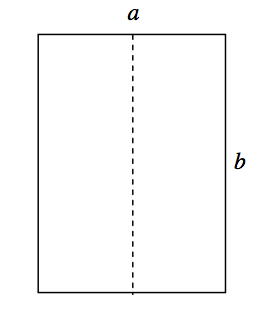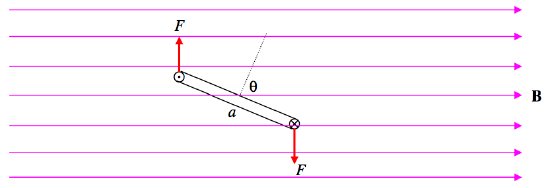7.5: Magnetic Moment of a Plane, Current-carrying Coil
( \newcommand{\kernel}{\mathrm{null}\,}\)
A plane, current carrying coil also experiences a torque in an external magnetic field, and its behaviour in a magnetic field is quite similar to that of a bar magnet or a compass needle. The torque is maximum when the normal to the coil is perpendicular to the 3 magnetic field, and the magnetic moment is defined in exactly the same way, namely the maximum torque experienced in unit magnetic field.
Let us examine the behavior of a rectangular coil of sides a and b, which is free to rotate about the dashed line shown in Figure VII.2.

FIGURE VII.2
In Figure VII.3, I am looking down the axis represented by the dashed line in Figure VII.2, and we see the coil sideways on. A current I is flowing around the coil in the directions indicated by the symbols ⨀ and ⨂. The normal to the coil makes an angle θ with respect to an external field B.

FIGURE VII.3
According to the Biot-Savart law there is a force F on each of the b-length arms of magnitude bIB, or, if there are N turns in the coil, F=NbIB. These two forces are opposite in direction and constitute a couple. The perpendicular distance between the two forces is asinθ, so the torque τ on the coil is NabIBsinθ, or τ=NAIBsinθ, where A is the area of the coil. This has its greatest value when θ=90∘, and so the magnetic moment of the coil is NIA. This shows that, in SI units, magnetic moment can equally well be expressed in units of A m2, or ampere metre squared, which is dimensionally entirely equivalent to N m T−1. Thus we have
τ=pmBsinθ,
where, for a plane current-carrying coil, the magnetic moment is
pm=NIA.
This can conveniently be written in vector form:
τ=pm×B,
where, for a plane current-carrying coil,
pm=NIA.
Here A is a vector normal to the plane of the coil, with the current flowing clockwise around it. The vector τ is directed into the plane of the paper in Figure VII.3
The formula NIA for the magnetic moment of a plane current-carrying coil is not restricted to rectangular coils, but holds equally for plane coils of any shape; for (see Figure VII.4) any curve can be described in terms of an infinite number of infinitesimally small vertical and horizontal segments.

FIGURE VII.4
We understand that a magnet, or anything that has a magnetic moment, experiences no net force in a uniform magnetic field, although it does experience a torque. Furthermore, as in the case of an electric dipole in an electric field, a magnetic dipole situated in an inhomogeneous magnetic field does experience a net force. If the magnetic moment and the gradient of the magnetic field are in the same direction, the net force on the dipole is
pmdBdx.
[N m T−1×T m−1=N.]
See Section 3.5 for further details relating to a dipole in an inhomogeneous field.
An important historical experiment that readers may come across, using the force on a magnetic dipole in an inhomogeneous magnetic field, is the 1922 experiment of Stern and Gerlach, demonstrating the spatial quantization of the magnetic moment associated with electron spin.


